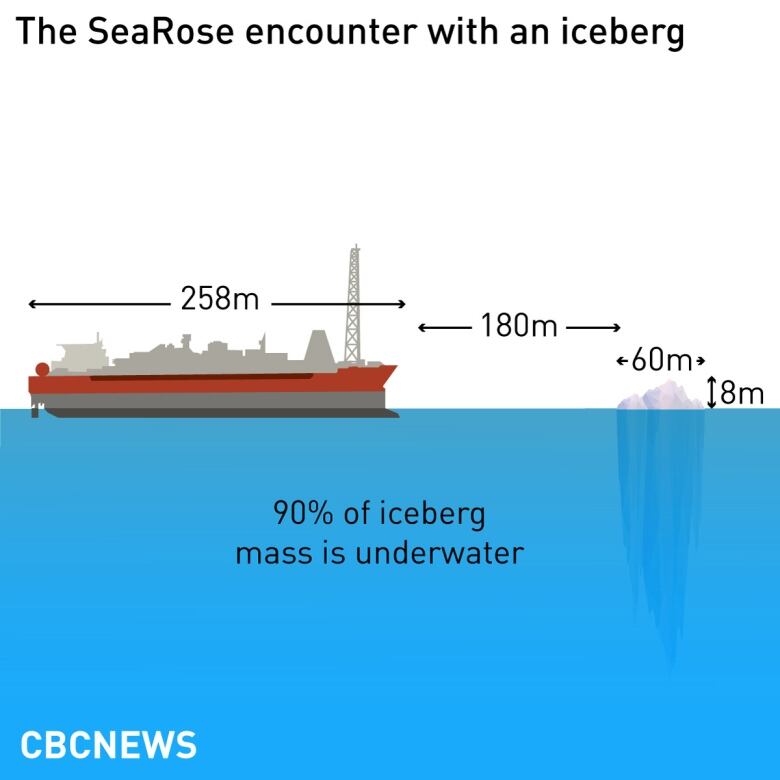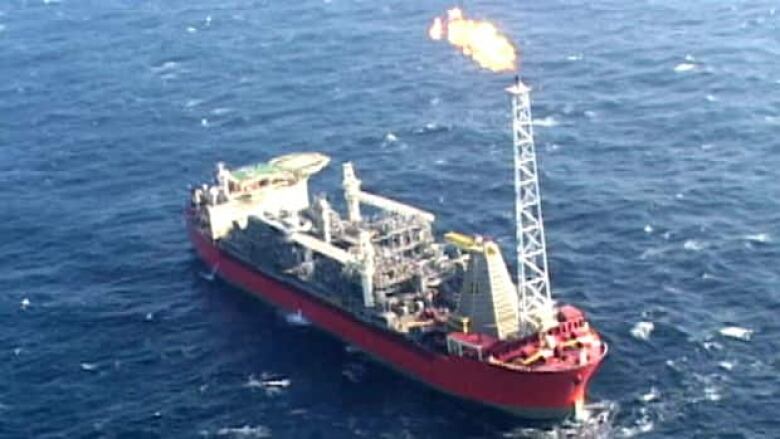Investigation shows Husky's decision not to move out of iceberg's path in close call 'economically driven'
Husky Energy broke the rules when the SeaRose had a close call with an iceberg in March 2017

Husky Energydecided for financial reasons not to disconnect the SeaRose floating production, storage and offloading vessel (FPSO) when an iceberg drifted too close to it lastMarch, according to records obtained by CBC News.
Eighty-four people on board were ordered to muster and to brace for impact on March 29, 2017, according to Scott Tessier, head of theCanada-Newfoundland and Labrador Offshore Petroleum Board (C-NLOPB),the regulatory body for the offshore oil industry. The iceberg came within 180 metres of the structure.
The iceberg measured 60 by 40 metresand was eight metres high.
An official in the provincial Department of Natural Resources wrote in an email on Jan. 17that during a discussion about theSeaRose'sclose call with an iceberg, Tessier said that "the investigation showed that Husky's decision was economically driven."
The email was among 68 pages of records released underNewfoundland and Labrador's Access to Information and Protection of Privacy Act (ATIPPA).
The offshore regulator suspended Husky's operations for nine days last month 10 months after the incident because it did not close down production and sail away when theiceberg came close to theSeaRose, said Tessieron Jan. 17.

The iceberg came within 180 metres of the SeaRose, which had 340,000 barrels of oil in storage on board at the the time.The SeaRose is 258-metres long, meaning that the iceberg got nearly as close ashalfthe length of the FPSOitself.
At the time of the suspension, Tessier said that it would have taken weeks to get back into production had the SeaRose shut down production and gotten out of the way.
"I suspect in the order of six to seven weeks," he said.
Husky's suspension lasted nine days because the C-NLOPB said it was satisfied that Husky took appropriate action to "address the deficiencies that were identified within the safety culture of their organization," according to a news release.
- SeaRose shut down after Husky reprimanded for iceberg close call
- Offshore regulator questions who's in charge of SeaRose after iceberg scare
- Husky's SeaRose can resume production, regulator withdraws suspension
CBC News requested an interview with Tessierabout thecomment regarding Husky's financial motivation in defyingice management regulations, but a C-NLOPB spokespersonsaid it would be inappropriate because the investigation is still ongoing.
Prepared comments by C-NLOPB at the time of the suspension, which were among the documents released to CBC News, said that to take tougher action with Husky in the absence of a completed investigation would have been "capricious and arbitrary" and "subject to legal challenge."

Husky dispatched top brass to deal with fallout
CBC News also asked Husky to address whether economic considerations factored into its decision to contravene the ice management plan.
"We are absolutely committed to ensuring this can't happen again and the plans and procedures we are implementing will ensure that is the case," a Husky spokesperson said by email.
Husky dispatched top brass from its head office in Calgary to St. John's to deal with the fallout from the suspension of oil production last month, according to meeting minutes obtained by CBC News.
The records show that Tessiercommunicated to Husky management that it needed to consider "what it is in Husky's culture that blocked the decision to disconnect, and then defended it as the right thing to do."
He also asked the company to "review decisions made in recent cost cutting that may have detrimentally affected ice management."
Senior Husky managers remained in Newfoundland until the issue was resolved. And in a management shakeup last month, Husky Energy replaced Malcolm Maclean, its senior vice-president for the Atlantic region.
This measureas well as amanagement and emergency response planconvinced the C-NLOPB that Husky could safely resume oil production on the SeaRose, 350 kilometres to the east southeast off the coast of Newfoundland.
Husky did issue a public notice at the time the SeaRose came in close contact with the iceberg last March. But few details were made public until the C-NLOPB issued its own notice nearly a year later.
The records obtained under ATIPPA saidthat C-NLOPB did not plan to discuss the issue publicly unless it was directly asked about it.

Investigation remains open
Tessier wrote that C-NLOPB did not plan any "proactive public communications" and would speak to the close call only if it re-entered "the public domain" because itsinvestigation was open.
Newfoundland and Labrador's Natural Resources MinisterSiobhanCoadydid not agree toan interview request.
"We understand an investigation remains open regarding the incident in March 2017. We suggest talking to C-NLOPB directly regarding the status of that investigation and its outcomes," Coady said in a statement Friday.
The provincial government earns about $200,000 a day in royalties from oil production on the SeaRose.












_(720p).jpg)


 OFFICIAL HD MUSIC VIDEO.jpg)
.jpg)



























































































